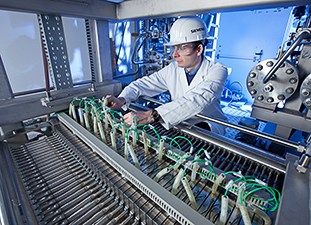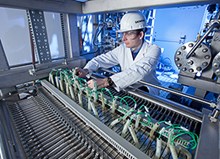Manufacturers across industrial sectors face universal challenges. They include ensuring maximum plant availability, delivering strong productivity performance and putting in place a robust and long-term preventative maintenance strategy.
Sitting at the heart of how companies can better perform in these vital areas is the growing influence and adoption of digital technology solutions. With the extraction, storage and analysis of data key to providing a solid foundation from which informed decisions can be made, the importance of a strategic approach to digital implementation cannot be underestimated.
For many industrial sectors, traditional approaches still prevail. Sweating assets remains the default position, while, for many, a reluctance to look at whole lifecycle costs of an asset, means many are in danger of losing out as the digital revolution transfers to the industrial sector.
However, on the flip side, it is now clear that manufacturers with an open mind are increasingly looking at alternative models to support their drive for the benefits digitalisation offers.
For instance, some are investigating with interest the kind of servitisation model now being offered by vendors such as Siemens which is opening up a real world of possibility.
In a typical scenario, a customer may want to install a new asset or production equipment on site to improve their competitiveness or, for example, tackle energy consumption. They would raise the required capital via their CAPEX programme and procure from a machine builder where Siemens would work on technology specification. The OEM would install the new asset on site with standard warranty terms and the end user is left to ensure the asset performs through its lifetime.
In a new world, Siemens offers a service to deliver an ‘outcome’ the end user wanted from the equipment over a period of time. Siemens procures and installs the asset and delivers a performance-based service with the customer being charged a monthly operating or service fee. This shift from CAPEX to OPEX makes the customer more competitive, allowing them to spend on other strategic investments and improving their cash flow.
Critically, it allows the customer to more easily entertain the specification of new digital technologies and develop an overall digital strategy to help improve the capture, visualisation and interpretation of data insight that is so crucial to commercial success.
In terms of assets, we are also seeing moves towards an increased use of digital solutions. For CNC machining prevalent in the aerospace and automotive sectors, the loss, for example of high-value tools such as drill bits can lead to real issues around maintaining production performance.
However, the ability to continually sense the health of the tools, receive intelligent feedback from sensors and adopt preventative strategies, will alleviate the potential for unexpected failure and with it production problems. It also helps to signal a failure is imminent and provide warning for operators to investigate if replacement stock is available. This will provide a step change in performance, as well as reducing costs.
There remains slightly more reticence in the standard drives market when it comes to digital adoption. The issue of increased cost for an asset that is currently performing often meets resistance from finance departments, despite the compelling case made by the engineering community.
However, with the development of technology, it is highly likely that such assets will include embedded technology such as sensors within the next three to five years. Companies utilising these answers will reap the benefits in terms of better component insight.
We are currently on the cusp of a new era where cloud-based technologies and artificial intelligence will enable manufacturers to far better utilise the data extraction that has already been available for a number of years.
Rather than manufacturers commenting that they have ‘too much data’ and ‘don’t know what to do with it’, digital technologies will not only shine a light on the current status of assets but also generate predictions around future performance characteristics and learn from past scenarios. The ability to access this intelligence via an eco-system of apps linked to the cloud means more insight, more agility and more informed decision making.
Ultimately, it is about unlocking the true potential of manufacturing performance, removing the glass ceiling that is holding some companies back, and adding true value to a business that has to compete ever harder in order to ensure success.
Digitalisation technologies, which include the Internet of Things(IoT), advanced materials, 3D printing, digital twins, simulation, additive manufacturing, advanced analytics, artificial intelligence and robotics, are now reaching a level of cost and performance that is starting to encourage widespread adoption across industrial sectors.
Last year’s Made Smarter Review cited that industrial digitalisation could boost UK manufacturing by £455bn over the next ten years, grow the nation’s manufacturing sector by 3% per annum and enable Great Britain to be a world leader in the fourth industrial revolution. It can deliver the improvements in productivity, manufacturing flexibility, growth and competitiveness that will be music to the ears of our industrial community.
Embracing the potential that digital technology solutions offer makes sound business sense for manufacturers at a time when there has never been more support and technological innovation to help them do so.


